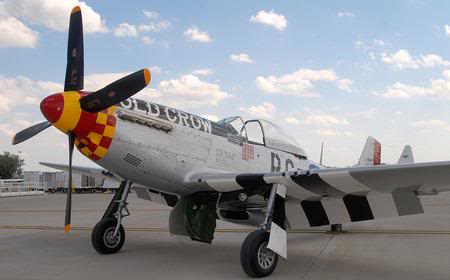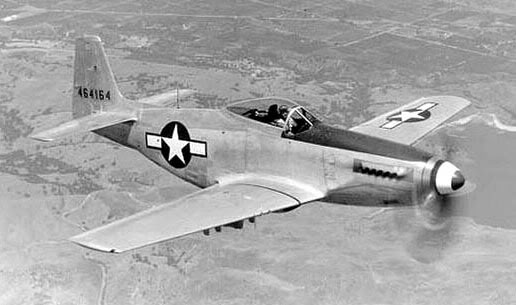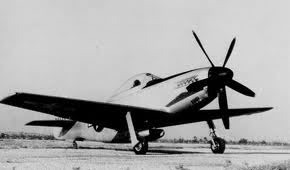North American P-51 Mustang
Page 1 of 1
 North American P-51 Mustang
North American P-51 Mustang
THE NORTH AMERICAN P-51 MUSTANG


the P-51 Mustang was buy far one of the finest fighters of WWII, many experts believe it was the best fighter of the war. it earned the nick name Cadillac of the sky buy its pilots beacuse of its long range, spacious cockpit, ease of flight, and stellar performance. and "guardian angel." buy many of the men it protected. its unequaled performance made it legionary, it was faster than most all piston powered fighters, had a decent roll rate and could out turn most all of its opponents it faced, yet at the same time it had a range and loiter that some other fighters with lesser performance could only dream of.
as good as the P-51 Mustang was its beginnings where not a stellar, it began its life as a import fighter, the British where looking too purchase a batch of P-40s but the North American Aviation Company promised a better air frame in less time, and delivered, the prototype took off in less than 150 days, a impressive delivery time, it featured new design implements such as laminar flow wings, which allowed less drag with almost the same amount of lift as a standard airfoil, it also featured a new radiator design which exploited the Meredith effect, (the creation of thrust using the heat of the radiator.) the radiator was placed in a scoop blended in with the fuselage below the wings, this system created enough thrust to cancel out the drag the radiator created.
these new innovations, along with a cutting edge stream lined airframe, the Mustang was faster than the P-40 with the same power, it was actually even faster than the current spitfire. tests where done and it showed other low altitude performance qualities that made it a promising fighter. however it had its set backs, the new fighters high altitude performance was very limited, its single stage single speed supercharged Allison V-1710 V-12 lacked the performance at high altitudes, above 15,000ft it would perform very poorly, this limited the fighter too the ground attack role beacuse most areal engagements a fighter would be involved in would be above 15,000ft. the P-51 saw large service as the A-36 Apache, there it earned the name Mustang by the british! it also saw service buy the country who created it in its early services, some of them equipped with 20MM cannons, its low level speed made it a good attack aircraft!
P-51A Mustang

A NEW ENGINE THAT CHANGED ITS OUTLOOK
The P-51B and P-51C Mustang where almost the same aircraft, the differences between the two aircraft where very minute!

despite its impressive performance it still had weaknesses, the P-51B-Cs birdcage stile canopy provided mediocre rearward visibility, its 4 .50 caliber machine guns had to be staggered to fit in its thinner wings, causing them to jam if they where fired in extremely strenuous conditions, the new merlin also had a little more torque than the Allison, the Merlin would twist the airplane into a spin if the pilot applied the throttle too quickly at lower speeds, and the new aft tank knocked off the mustangs center of gravity, with it full, if the mustang was turned too hard, or lost too much airspeed into a turn, it would stall without warning, sometimes violently, breaking off its Horizontal stabilizers in the spin, but removing about 20 to 30 gallons from the aft tank or burning it on takeoff before switching to its main tanks or drop tanks helped corrected this issue with little sacrifice too range.
the P-51B-C was only the beginning of the P-51 line, a new variant was developed, the P-51D Mustang. the P-51D Mustang was designed to be more suitable for combat, it was designed too "Fix" a lot of the issues associated with the P-51B and C Mustangs. the easiest feature too distinguish the D Mustang was the teardrop shaped bubble canopy, this allowed the pilot a full 360 degree view of the battlefield, superior visibility was arguably better than most all of the fighters of the time, but this was not the only new feature it was given, it also receaved the new Rolls Royce Packard Merlin V-1650-7 V-12 as the standard engine for the aircraft, this engine had a slightly higher power output at takeoff, its supercharger ratio was reduced too provide more boost at lower altitudes without risking over boosting the engine. the P-51D Mustang also featured thicker wings, this meant the guns no longer had to be staggered, in addition too that two extra guns where mounted inside its wings, now instead of having four .50 caliber machine guns, it had six! and now could carry 1,880 rounds of ammunition! its bomb load carrying capabilities where also increased, it was capable of carrying 500LB heavier payload! a pair of 108 gallon paper drop tanks also became a option too increase the mustangs range too 2,080 Miles! in the introduction of the P-51D-10 Mustang a dorsal fin was added to increase the over all surface area of the vertical stabilizer "tail fin." too add stability and also rigidity too the tail section in instance the pilot was too stall his airplane helping prevent the horizontal stabilizers from ripping off! with all these new features the P-51D Mustang however lost some airspeed due too the extra drag, the P-51D Mustang went from having a top speed under military power of 441MPH too 437MPH... but with War Emergency Power, a top speed of 448MPH could still be achieved. the loss of over all top speed was a necessary sacrifice for its improvements.
later variants like the P-51D-30 where equipped with all sorts of new goodies such as the K-14 Gyroscopic computed self leading gun sight, tail warning radar that would attempt to alert the pilot of enemy aircraft on there tail, rearward mirrors attached too the canopy too assist the pilot in seeing behind them, and more advanced cameras and communication radios, but some pilots chose not too have these accessories simply beacuse they added weight too the aircraft.
P-51D Mustang

WHAT THE MUSTANG DID BEST.
three P-51D Mustangs flying in formation with a B-17 the Mustang was almost perfect for the escort role beacuse of its stellar performance and long range. it could fly with the bombers, all the way there and all the way home, and protect them very well

the P-51 Mustangs only really major weakness was its liquid cooling system, its radiator could be pierced by a lucky peace of flak or small arms fire, this would cause the mustang to over heat and go from a very deadly and effective fighter, too a short ranged glider... but this weakness was often greatly overlooked, as the Mustang was often compared too fighters like the P-47 Thunderbolt with air cooled engines and heavily constructed airframes. the liquid cooling system was a liability it shared with other fighters like the BF-109 Messerschmitt, and the Super Marine Spitfire, and by no means out weighed its stellar performance characteristics and combat effectiveness.
POST WAR!
after WWII the P-51 continued to be used in service, aircraft like the P-51H Mustang for example where used still as a fighter during the Korean war rather than just purely as a ground attack aircraft. the P-51H Mustang was a impressive fighter, the P-51H featured some design changes, a lengthened fuselage, some design changes too the wing, changes too the dorsal fin and a few other things. the biggest difference between the P-51H and P-51D was the engine, the new P-51H featured the new Rolls Royce Packard Merlin V-1650-9 V-12 engine. the new engine created around 2,200HP with War Emergency Power, the P-51H had a top speed of 487MPH. the P-51 Mustang continued too be used buy militaries all the way until the 1980s, and some variants where converted to turboprop like the Piper PA-48 Enforcer, and where finally retired in 1984!
P-51H Mustang

PA-48 Enforcer

CONCEPTS AND SUPER MUSTANGS!
During the war light weight mustangs where being experimented with, when the mustang was fully loaded it was very heavy, especially later mustangs with all the optional bells and whistles, having the mustang fully loaded and so heavy hindered the mustangs performance. even the mustang at its lightest, even though it performed well, many believed the mustang could still perform better! what if the mustang was built light like the spitfire or the 109, how much better it could perform then! experiments where done too reduce the weight of the mustang, without effecting its structural integrity too much. the first of the searies of high performance light weight mustangs, was the XP-51F, it featured a three blade prop rather than a four too reduce weight, several other things where done to reduce the aircrafts weight, when all was said and done the light weight XP-51F was over 1,000LB lighter than the P-51D. but development did not stop, experimenting continued until a monster was made, a aircraft that was possibly the best performing P-51 ever... the XP-51G! the XP-51G Mustang was still over 1,000LB lighter than the P-51D, but featured a engine similar too the engine that was in the P-51H, it created over 2,000HP, and the aircraft was propelled buy a massive five blade prop to absorb all the power on the streamline light weight aircraft, the increase in power and the decrease in weight, along with a few other airframe stability and streamlining modifications made the aircrafts performance outstanding. the XP-51G was finally flown and had a top speed exceeding 490MPH! it had a rate of climb of over 5,000FPM! it had a service sealing only limited too 46,000ft due too the simple fact the cockpit was not pressurized. however this monster never went into production for the simple fact it really was not needed, the P-51D Mustang was already doing its job well... enough. and with the invent of jet fighters the attention too fighters like these got drawn away, but just think of the possibilities.
the XP-51G possibly the best performing P-51 ever made.

STATISTICS!
P-51D Mustang (basic variant)
Engine
One liquid cooled two stage two speed supercharged Rolls Royce Packard Merlin V-1650-7 V-12 1,490HP at takeoff 1,695HP at military power 1,720HP at war emergency power
Propeller
Hamilton Standard four blade
Top speed
437MPH at military power 448MPH at war emergency power at 25,000ft
Top speed at sea level
367MPH
Rate of climb
3,475fpm
Rate of roll
90 degrees per second
Service sealing
41,900ft
maximum dive speed
~601 MPH
Armament
6 wing mounted browning AN/M2 .50 caliber machine guns, 400 rounds per gun in the inboard pair of guns, 270 rounds on the outboard and center pairs.
Ordinances
in provision for the #2 1,000LB Bombs #2 500LB Bombs #2 250LB Bombs or #8 HVAR Rockets. combinations of rockets and bombs where possible.
 Similar topics
Similar topics» P-51D Mustang-vs FW-190D-9 which is better.
» 1/48th scale Revell Monogram Ace Of Spades P-51D Mustang #3
» 1/48th scale Revell Monogram Ace Of Spades P-51D Mustang #3
Page 1 of 1
Permissions in this forum:
You cannot reply to topics in this forum|
|
|

 Home
Home